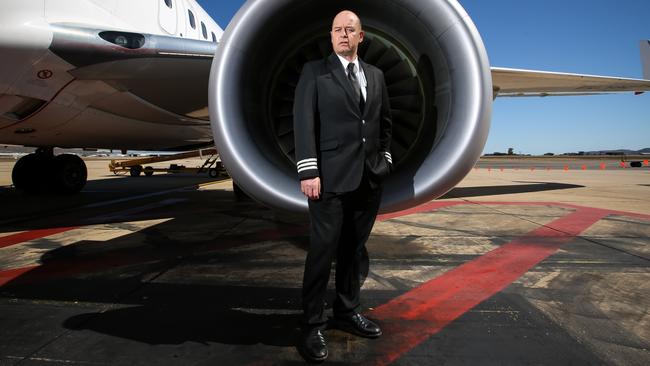Sky’s the limit but safety stops at 10,000ft
Air radar systems at some regional airports are not being fully used at lower altitudes, Virgin Australia pilots have warned.

Air travel to and from some regional airports is “nowhere near” as safe as it should be because available radar systems are not being fully used at lower altitudes, Virgin Australia pilots have warned.
Entering a growing debate over air safety, the Virgin Independent Pilots Association called yesterday for greater use of radar and radar-like surveillance systems to guide planes at regional airports.
VIPA spokesman Matthew Bowden, an experienced pilot, told The Australian yesterday that planes arriving at regional airports were typically switched off from radar surveillance and control at 10,000-12,000 feet.
He said this occurred even at airports that had radar or radar-like coverage well below these altitudes, including Hobart and Launceston, Ballina in NSW, and Proserpine and Mackay in Queensland.
“There is low-level radar surveillance in place but we are not using it,” Mr Bowden said. He described this as mystifying, given the superior safety of radar control.
Instead, at those airports that have air traffic control towers, controllers work to avoid collisions by “procedural separation”, based on pilots radioing in their positions and on visual observations.
“There are multiple regional airports that have low-level radar coverage and we would advocate that, wherever there is radar surveillance, we should provide a radar service to low level — just like we do in Melbourne, Sydney and Brisbane (airports),” Mr Bowden said.
“Commonsense should prevail. If you can have the accuracy (of radar) available at Sydney and Brisbane then surely you can find a way of having the accuracy available at these regional airports.”
VIPA’s position adds to a string of concerns about regional air safety management in Australia, amid frustration that regulators are failing to maximise the use of radar and ground staff observations to assist pilots.
Newly appointed Civil Aviation Safety Authority chairman Jeff Boyd has foreshadowed a shift towards a safer US-style model, with improved control of regional airspace.
In response to VIPA’s latest concerns, an Airservices Australia spokesman said radar was used by air traffic controllers “in all types of airspace where coverage is available”.
Mr Bowden said some airports, such as Ballina and Proserpine, did not have air traffic control towers, but did have low-altitude radar that was not used.
He said that where it was available it should be used to extend the service provided by radar controllers, centralised in Melbourne and Brisbane, rather than merely as an add-on tool for local tower controllers.
In particular, full support by radar to low altitude was far safer in bad weather, when visibility was poor.
“In bad weather, a radar controller is watching us (on radar screen) all the way until we are established on approach (to the runway),” Mr Bowden said.
VIPA was “perplexed” as to why Airservices spent $6 million installing a radar-like system in Tasmania, capable of providing coverage to ground level, but still relied on the less safe procedural separation below 12,500ft.
“Why would you bother spending $6m, or any amount of money, on a radar surveillance system, if you are not going to let the radar controller use it?” Mr Bowden said.
Aviation sources said the Civil Aviation Safety Authority often did not approve the use of radar as the primary means of separating aircraft above regional airports because of patchy coverage. For example, coverage of the Tasmanian radar-like system is deemed by CASA to be insufficient below 7000ft. Instead, it is used only as an additional tool to assist tower controllers.
Pilots argue that any inadequacies should be addressed to bring existing radar up to scratch for use at lower altitudes.
Multiple industry sources say Airservices failed to install a sufficient number of ground signal units to support the use of the Tasmanian system to control aircraft below 7000ft.
Airservices argues this was not necessary because air traffic volumes in Hobart and Launceston are far below those of Sydney and Melbourne.
Mr Bowden said there may be a case for extending radar to other regional airports where it could be supported by cost-benefit analysis. At the very least, where radar already existed, it should be used to maximise safety above regional airports.
“It is nowhere near as safe as it could be if we used the (radar) surveillance in the way it is supposed to be used — by a radar controller,” he said.
Airservices and CASA insist all airspace is managed safely and in accordance with the level of air traffic experienced.
CASA said questions relating to radar use at low altitudes over regional airports were of an “operational” nature and most appropriately directed to Airservices. By late yesterday, Airservices had declined to make someone available for interview. However, a spokesman — as well as saying air traffic controllers did make use of radar where available — defended Airservices’ handling of the Tasmanian radar project.
“In Tasmania, the Wide Area Multi-lateration (WAM) ‘radar’ system … gives visibility of all aircraft down to the ground in Hobart and Launceston,” he said.
“The WAM system not only supports air traffic controllers in providing services that keep flights safely separated from other traffic, but also enables controllers to assist pilots with navigation, weather or terrain avoidance.”




To join the conversation, please log in. Don't have an account? Register
Join the conversation, you are commenting as Logout